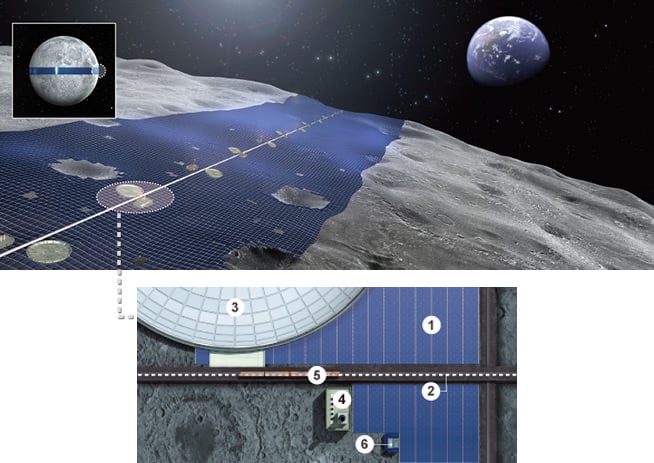[/caption]
Space based solar power? How about a Moon-based solar collector that would beam energy back to Earth. This is just one idea proposed by a 200-year-old Japanese construction company,
Shimizu
that prides itself in forward-thinking technology and structure development. For this "Luna Ring," an array of solar cells would extend like a belt along the entire 11,000 km lunar equator, and laser power transmission facilities would beam a high-energy-density laser towards receiving stations on Earth.
See more on the Luna Ring, plus plans for orbiting hotels, Moon bases, mega-pyramid cities, and more, below.
[caption id="attachment_66110" align="aligncenter" width="580" caption="Energy gather on the Moon would be beamed back to Earth. Credit: Shimizu."]
[/caption]
For this structure to be successful, teams of astronauts would have to support robotic surface operation on site. So, they would need a lunar base. Shimizu has that design in mind, too.
[caption id="" align="alignnone" width="570" caption="A proposed lunar base made of hexagonal structures. Credit: Shimizu"]
[/caption]
Lunar bases could be constructed using concrete made from lunar regolith. Using a hexagonal shape would allow for multi-directional future extension of the structure. Unmanned construction systems will be a critical matter in the severe lunar environment. The concept of self-assembling structures using membranes and air-inflation systems could realize light-weight structures and reduce transportation costs. Shimizu is also developing construction robot technologies that could be applied to constructing a lunar base, minimizing the hazards of manned activities.
[caption id="" align="alignnone" width="250" caption="An interior view of a potential lunar base. Credit: Shimizu"]
[/caption]
For long-term manned mission, the interior of base should be designed considering 1/6 G gravity environment.
The Shimizu Corporation says they have been accumulating technological skills over 200 years and would welcome the challenge of applying them to the new frontier of the moon, while continuing R&D on structures, materials, construction systems, and design of lunar bases.
[caption id="" align="alignnone" width="570" caption="A space elevator hotel, 240 km above the Earth. Credit: Shimizu"]
[/caption]
Shimizu has this concept for a space hotel, which includes a space elevator, approximately 240 km long, for "easy" access from Earth (building a space elevator will not be easy), but visiting spacecraft could dock as well. This large complex structure would be composed of several modules, such as a lobby, restaurants, and an area for recreation.
[caption id="attachment_66112" align="aligncenter" width="580" caption="he Mega-City Pyramid stands 2,000 meters (1.25 miles) high. Credit: Shimizu"]
[/caption]
Shimizu is also looking at how they could build incredible structures on Earth that would house people and buildings on the oceans. The Mega-City Pyramid is a self-contained city for one million people. The basic structure—an assembly of regular octahedral units composed of shafts made from lightweight materials such as carbon fiber would be a project of unprecedented scale and proportion.
This video provides a look at some of the potential problems and hurdles to overcome for this type of structure:
[caption id="" align="alignnone" width="570" caption="Floating environmentally green islands with cities in the air. Credit: Shimizu "]
[/caption]
This "green" floating village would be almost like a giant lily pad floating on the water. Shimizu wants to create these cities that would act just like a lily, absorbing CO2 like a plant, as well as using other environmental technologies to achieve a carbon negative system. Solar power and resources from the ocean, as well as converting waste into energy would be used to give the floating city 100% self-sufficiency.
Visit the
Shimizu website f
or more information about the company, and see their
"dream" section
for more information about these futuristic mega-projects.
Source:
Shimizu,
via
Pink Tentacle
 Universe Today
Universe Today
